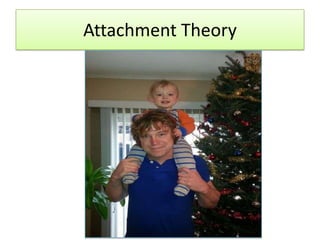Attachment Theory Developmental Psychology
•Download as PPTX, PDF•
15 likes•5,126 views
A brief history and overview of attachment theory
Report
Share
Report
Share

Recommended
Recommended
More Related Content
What's hot
What's hot (20)
Viewers also liked
Viewers also liked (20)
Penerangan Program Gen-G HHHC 9201 (Kemahiran Komunikasi)

Penerangan Program Gen-G HHHC 9201 (Kemahiran Komunikasi)
Similar to Attachment Theory Developmental Psychology
Similar to Attachment Theory Developmental Psychology (13)
Attachment Programs and Families Working Together Learn.docx

Attachment Programs and Families Working Together Learn.docx
Recently uploaded
This presentation was provided by William Mattingly of the Smithsonian Institution, during the third segment of the NISO training series "AI & Prompt Design." Session Three: Beginning Conversations, was held on April 18, 2024.Mattingly "AI & Prompt Design: The Basics of Prompt Design"

Mattingly "AI & Prompt Design: The Basics of Prompt Design"National Information Standards Organization (NISO)
Recently uploaded (20)
Russian Escort Service in Delhi 11k Hotel Foreigner Russian Call Girls in Delhi

Russian Escort Service in Delhi 11k Hotel Foreigner Russian Call Girls in Delhi
Presentation by Andreas Schleicher Tackling the School Absenteeism Crisis 30 ...

Presentation by Andreas Schleicher Tackling the School Absenteeism Crisis 30 ...
Web & Social Media Analytics Previous Year Question Paper.pdf

Web & Social Media Analytics Previous Year Question Paper.pdf
Disha NEET Physics Guide for classes 11 and 12.pdf

Disha NEET Physics Guide for classes 11 and 12.pdf
A Critique of the Proposed National Education Policy Reform

A Critique of the Proposed National Education Policy Reform
Beyond the EU: DORA and NIS 2 Directive's Global Impact

Beyond the EU: DORA and NIS 2 Directive's Global Impact
Measures of Central Tendency: Mean, Median and Mode

Measures of Central Tendency: Mean, Median and Mode
Mattingly "AI & Prompt Design: The Basics of Prompt Design"

Mattingly "AI & Prompt Design: The Basics of Prompt Design"
Attachment Theory Developmental Psychology
- 2. Attachment Attachment : refers to the close, emotional bonds of affection that develop between infants and their caregivers.
- 3. The Formation of Attachment Theory Psychology and medicine discouraged emotional affection and physical contact in the early 1900s. Many Psychologists believed that emotional affection led to poor mental health. Medical Practitioners noticed a relationship between physical contact and sickness.
- 4. The Formation of Attachment Theory A researcher named Harry Harlow decided to evaluate how contact comfort influence the social development of a group of rhesus monkeys in the late 1950’s.
- 5. The Formation of Attachment Theory • Feed by wire mother • Feed by cloth mother
- 6. Attachment Theory This research led John Bowlby to theorize that infants had a biological need for contact comfort (love). Infants are biologically programmed to coo, smile, and flirt to get an emotional response from the caregiver (attachment).
- 7. Features of Attachment Proximity Maintenance: the need to be physically close to the attachment figure Seperation Anxiety: the emotional distress seen when separated from the attachment figure Safe Haven: retreating to the attachment figure when scared Secure Base: a feeling of being able to explore the world because of the dependability of the attachment figure
- 8. Types of Attachment Mary Ainsworth, a colleague of Bowlby, expanded attachment theory by type (secure/insecure). She developed each type through a series of observational studies called “ the strange situation.”
- 10. Secure Attachment Babies will freely explore their environment and occasionally return to parent for comfort. Babies will cry when parent leaves, but crying quickly stops when parent returns. Most babies have a secure attachment to their caregiver (60%).
- 11. ( Insecure) Anxious-Ambivalent Attachment Babies are reluctant to leave the side of the parent. Babies show hostility toward parent upon return, often crying for extended periods. About 10% of babies are found to have anxious-ambivalent attachment.
- 12. (Insecure) Avoidant Attachment Babies show little interest in parent, often not crying when parent leaves. Upon return, babies continue to show little interest and will not seek contact comfort. About 15% of babies show an avoidant attachment.
- 13. (Insecure) Disorganized Attachment Main and Solomon (1986) Babies show no consistent reactions. Both anxious-ambivalent and avoidant attachment are present. Babies appear to make little, if any, eye contact. About 15% of babies are found to have disorganized attachment.
- 14. Attachment and Personality Development Secure: confident, trusting, friendly Anxious-Ambivalent: jealous, not confident, underappreciated Avoidant: suspicious, aloof, skeptical Disorganized: moody, fearful, stress sensitivity
- 15. Interesting Controversy On Becoming Baby Wise: Giving Your Infant the Gift of Nighttime Sleep is a book written by Gary Ezzo (former MVCC student) and Robert Bucknam. The book encouraged parents to “direct” the feeding, sleeping, and play activities of the newborn. Attachment proponents became critical calming the book encouraged the disruption of the attachment process.
- 16. Guess The Attachment Style The Grinch Avoidant?
- 17. Guess the Attachment Style Lindsey Lohan Anxious-Ambivalent?
- 18. Guess the Attachment Style Dr. Phil Secure?
- 19. References • Ainsworth, M. D. S. (1968), Object relations, dependency, and attachment: A theoretical review of the infant mother relationship. Child Development, 40, 969-1025. • Bowlby, J. (1958), The nature of the child’s tie to his mother. International Journal of Psycho-Analysis, XXXIX, 1-23. • Bowlby, J. (1988). A secure base: Parent-child attachment and healthy human development. New York: Basic Books. • Ezzo, Gary; Bucknam, Robert (2007). On Becoming Baby Wise: Giving Your Infant the Gift of Nighttime Sleep (4 ed.). Parent-Wise Solutions. • Harlow, H. F. (1958). The nature of love. American Psychologist, 13, 673-685 • Hinde, R. A. (1991). Relationships, attachment, and culture: A tribute to John Bowlby. Infant Mental Health Journal, 12, 154-163.